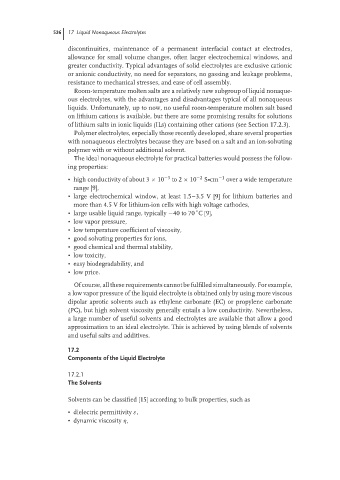Page 552 - Handbook of Battery Materials
P. 552
526 17 Liquid Nonaqueous Electrolytes
discontinuities, maintenance of a permanent interfacial contact at electrodes,
allowance for small volume changes, often larger electrochemical windows, and
greater conductivity. Typical advantages of solid electrolytes are exclusive cationic
or anionic conductivity, no need for separators, no gassing and leakage problems,
resistance to mechanical stresses, and ease of cell assembly.
Room-temperature molten salts are a relatively new subgroup of liquid nonaque-
ous electrolytes, with the advantages and disadvantages typical of all nonaqueous
liquids. Unfortunately, up to now, no useful room-temperature molten salt based
on lithium cations is available, but there are some promising results for solutions
of lithium salts in ionic liquids (ILs) containing other cations (see Section 17.2.3).
Polymer electrolytes, especially those recently developed, share several properties
with nonaqueous electrolytes because they are based on a salt and an ion-solvating
polymer with or without additional solvent.
The ideal nonaqueous electrolyte for practical batteries would possess the follow-
ing properties:
• high conductivity of about 3 × 10 −3 to 2 × 10 −2 S•cm −1 over a wide temperature
range [9],
• large electrochemical window, at least 1.5–3.5 V [9] for lithium batteries and
more than 4.5 V for lithium-ion cells with high voltage cathodes,
◦
• large usable liquid range, typically −40 to 70 C[9],
• low vapor pressure,
• low temperature coefficient of viscosity,
• good solvating properties for ions,
• good chemical and thermal stability,
• low toxicity,
• easy biodegradability, and
• low price.
Of course, all these requirements cannot be fulfilled simultaneously. For example,
a low vapor pressure of the liquid electrolyte is obtained only by using more viscous
dipolar aprotic solvents such as ethylene carbonate (EC) or propylene carbonate
(PC), but high solvent viscosity generally entails a low conductivity. Nevertheless,
a large number of useful solvents and electrolytes are available that allow a good
approximation to an ideal electrolyte. This is achieved by using blends of solvents
and useful salts and additives.
17.2
Components of the Liquid Electrolyte
17.2.1
The Solvents
Solvents can be classified [15] according to bulk properties, such as
• dielectric permittivity ε,
• dynamic viscosity η,

